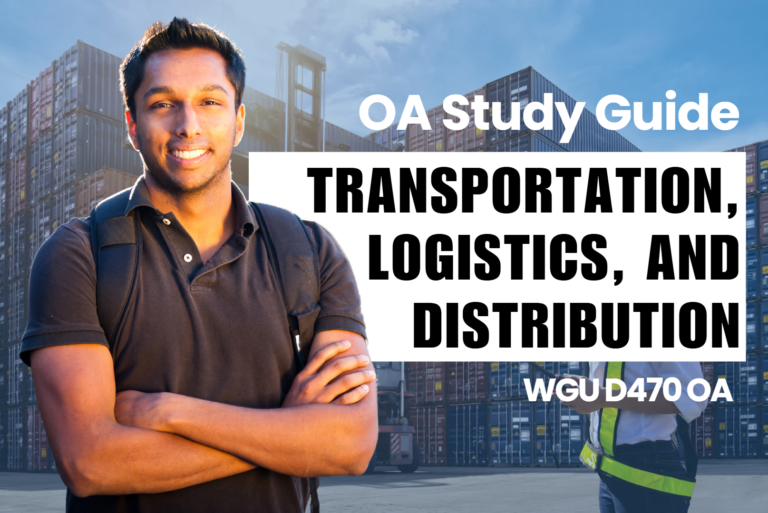Hello everyone! Welcome to our study guide for the WGU D337 OA – How to Pass Internet of Things (IoT) and Infrastructure module, specifically designed for WGU’s D337 Objective Assessment. We’ve put together a practical plan to help you do well in this module. We’ve carefully studied the course material to find the most important information you’ll need and how to get it. This guide aims to clear up any confusion you may have about preparing for the assessment, so you can feel confident going into it. Just follow our easy steps, and we’re confident you’ll succeed. We wish you all the best on your OA!!
...
About the module 📖
In Internet of Things (IoT) and Infrastructure WGU D337, we explore the basics and real-life uses of IoT, along with its connection to the cloud. Simply put, IoT involves linking various physical objects to the internet to make life easier. Each part of this course will walk you through the business needs for sensors and how they gather, send, secure, and process data. After covering the basics, we’ll also talk about the ethical and privacy issues that come with using this technology. With this knowledge, you’ll understand IoT thoroughly and learn about new ways it’s being used in the real world.
The module competencies are as follows:
Going forward, we will cover:
- Identifies Internet of Things (IOT) Architecture
- Determines Internet of Things (IOT) Business Requirements
- Describes Internet of Things (IOT) Security
- Defines Ethical and Privacy Issues
- Identifies Emerging Use Cases
After you have studied these competencies, your knowledge will be tested with an Objective assessment.To complete this module it is mandatory to pass this OA and get a satisfactory score.
Internet of Things (IoT) and Infrastructure WGU D337 OA consists of 60 MCQ questions and you will be given 2 Hours to attempt each of these questions. For your convenience, there will also be a Pre assessment to validate your knowledge and understand your weak points before attempting the OA. So let’s discuss how you can prepare for these hurdles and ace your assessments in your first try.
...
Study Plan To Prepare Yourself For Internet of Things (IoT) and Infrastructure WGU D337 OA 👇🏻
Step 1 – Read through the ETextBook “The Internet of Things: From data to insight”
One of the best aspects of this module is its manageable amount of course content, making it easier to navigate. Beginning with the ETextBook provided by WGU in the “course materials” serves as a solid starting point. It’s worth noting that all questions, both in the pre-assessment (pre-A) and the objective assessment (OA), are based on the material covered in this ETextBook. While there are two textbooks available, focusing on “The Internet of Things: From Data to Insight” is sufficient for a thorough understanding of the module. Align your study with the topics outlined in the WGU study guide and carefully go through the ETextBook as your first step. Taking concise notes and creating flashcards during your reading will provide valuable study materials for later review.
Additionally, leverage the Study notes shared by former students of the module, available in the course chatter section. The document titled “IoT Notes Revised.docx” offers a comprehensive overview of key concepts covered in the module. You can refer back to these notes anytime to reinforce your understanding or revisit topics you may have forgotten. Utilizing these resources alongside your textbook reading will help you grasp the material effectively and prepare for success in the module.
Step 2 – Go through our recommended Quizlet
We’ve identified one of the Quizlets created by a former student of the WGU D337 module as one of the best study materials you can refer to in your studies. We recommend going through this Quizlet from beginning to end, as it covers all the important information that you should retain for the OA. This is a valuable tool for memorizing the key terms in each topic of the book, which are frequently found in the OA questions. View Quizlet
Step 3 – Sit for the Pre-A
As mentioned earlier, the course content of WGU D337 is below average compared to other similar modules. Therefore, we assure you that going through steps 1 and 2 is sufficient preparation for the Pre-A. Ensure that you memorize the definitions and key concepts of each topic before starting the assessment. If needed, review the short notes and flashcards prepared in step 1 to refresh your memory. It’s important to treat the Pre-A as a real exam to gain a clear understanding of your readiness before attempting the actual exam. According to our research, we found that the OA is very similar to the Pre-A. Therefore, instead of rushing through the questions, carefully read each question and ensure you have a clear understanding before answering. With these considerations in mind, sit for the Pre-A and do your best to achieve the highest score possible.
Step 4 – Go through the Coaching report
Now that you have completed the Pre-A, whether you passed or not, you can find the auto-generated coaching report in the Pre-A section of the module. This report will help you identify your weaknesses in the study material. Take the time to go through the coaching report from top to bottom and note down the topics that you need to revisit. We advise you to take as much time as you need to revisit these topics in the ETextBook and the short notes. If you need further study materials, you can find the listed sources we have mentioned in the External Resources section of this article.
If you have failed the Pre-A, sit for the Pre-A again after going through the coaching guide. Make sure that you achieve the necessary score to pass the Pre-A before attempting the OA.
Step 5 – Ace the OA
Congratulations!! You have passed the Pre-A and confirmed that you are ready for the OA of WGU D337.Do not hesitate or be discouraged if it took you more than one attempt to pass the Pre-A. The important part is that you passed, no matter how many times it took you. Now you are prepared to schedule the OA at a time of your convenience and ace the module.We recommend that you schedule the OA as soon as possible while the course content is still fresh in your mind.
Hints:
1) Make sure you understand the Pre-A questions and answers ( you can refer to our Q&A article on the Pre-A of WGU D337). The questions on the OA are very similar in format/wording to the questions in the Pre-A
2) Read each question carefully. The wording in the OA questions is very tricky. Get a clear understanding of the question before answering.
3) If any question seems difficult, use the elimination method to find the correct answer. Go through each answer and eliminate the obvious wrong answers so only the correct answer remains.
Important Concepts and Topics of WGU D337 OA 🔑
We have identified below topics and concepts to be more significant than the rest when it comes to the OA of WGU D337. So understanding these concepts clearly will help you succeed in this module. You can find a clear description of each concept below to help you understand each concept better. Feel free to do your own studies on these concepts and memorize the information before attempting the OA.
Waves of IoT
1) First Wave
The primary goal of the first IoT wave is interconnection between different physical devices and the internet. It is designed to facilitate the communication of data through the connection of sensors, machines, and other objects to remote networks across the globe. This phase is known as the standardization phase, which aims to define simple connectivity protocols and standards that serve as building blocks for IoT. Industries, notably manufacturing, exploited this trend to run remote checks on their devices and preventative maintenance, thereby increasing their effectiveness and reducing machine downtime.
2) Second Wave
On the basis of the data connecting capability developed in the first wave, the second wave of IoT encompasses the addition of knowledge and computation techniques to the IoT systems. It encompassed data mining from devices that were interconnected and entailed visualizing data to derive actionable recommendations and engineering, refining, and planning processes. This stage marked the adoption of machine learning algorithms and analytics engines as well as their integration into various IoT solutions that allowed the prediction of the future condition of assets and their tracking by location. Along with this, IoT diffused into the popular end-products, such as smart home appliances and wearables, which are giving birth to smart homes and living.
3) Third Wave
The third wave of IoT represents a significant development as AI, machine learning, and edge computing settle in the existing system. Targeting this phase will process data closer to the source of the network, at the edge and decrease latency as well as bandwidth requirements. The AI and ML algorithms of IoT systems enable real-time processing of data that can autonomously decide and generate quick responses for enhanced productivity. This spurt is already taking place in IoT adoption from the health sector, transportation, agriculture and smart cities leading to new innovations like remote patient monitoring, autonomous vehicles, precision farming and good resource management.
Types of Data
- Sensor Data: Sensor data are the main type of data which the sensors of IoT devices generate. Such information may come from a variety of sensors, which are usually onboard the IOT devices, such as temperature sensors, motion sensors, humidity sensors, and whatnot. Data from the Sensors provides real-time visibility into the physical environment which allows measurement, analysis, and even control of IoT systems and devices. For binning, the exemplary sensor data are temperature readings, motion detection events, light intensity measurements and air quality measurements. Sensor data constitutes a key aspect for detecting altered conditions, variations and recurring events in the environment, hence facilitating and supporting decision-making and automation platforms.
- Metadata: Metadata is the description of anything that overlays upon IoT data, devices, and processes. As there is a need for more context and more details that will assist in reading the data, it serves this purpose. Metadata exemplifies attributes such as timestamps, device identifiers, location coordinates, sensor parameters, data quality markers, and data validation information. It is metadata which facilitates understanding, integration and credibility of IoT data through providing necessary information which describes its origin, trait as well as purposes. It provides data management, search, discovery and integration of data in the IoT ecosystem, and lets people look at data-governance, compliance and analytics in it.
- Dataset: In the realm of IoT, a dataset focuses on the data logs or observations of an IoT device over a given period. A dataset might have as many as several types of data, for example, sensor data, metadata, contextual information as well as annotations. Datasets are one of the most critical sources of IoT applications which are vital for the historical and current analysis, predictive modeling, and machine learning algorithms. They are the frame upon which self-learning models, anomaly detection algorithms and AI-enabled decisions are built in IoT environments. Data which is derived from IoT is useful to find the necessary insights, patterns, and trends, and support different use cases such as maintenance, smart cities, healthcare monitoring, and environment monitoring.
IoT Acts and Processes Used by Organizations
- ISO 27005: This standard provides organizations with guidelines for assessing and managing information security risks. It helps organizations identify potential threats to their IoT systems and data, evaluate their impact, and implement appropriate controls to mitigate risks effectively.
- Industrial Internet Reference Architecture (IIRA): Developed by the Industrial Internet Consortium (IIC), the IIRA offers a comprehensive framework for designing and deploying industrial IoT solutions. It provides guidance on architectural principles, interoperability, security, and scalability, enabling organizations to build robust and future-proof IoT ecosystems.
- BSI Kitemark: The BSI Kitemark is a widely recognized certification mark that signifies adherence to specific quality and safety standards. IoT products and services bearing the Kitemark have undergone rigorous testing and assessment, giving consumers confidence in their reliability, performance, and security.
- California Consumer Privacy Act (CCPA): CCPA is a state-level regulation aimed at protecting the privacy rights of California residents. It requires organizations to disclose their data collection and sharing practices, give consumers the right to opt out of data sharing, and implement safeguards to protect sensitive personal information. Compliance with CCPA is essential for organizations operating in California or handling data from California residents, including data collected through IoT devices.
- Vulnerabilities Equities Process (VEP): The VEP is a U.S. government initiative for evaluating and managing cybersecurity vulnerabilities. It helps prioritize resources for identifying, assessing, and addressing vulnerabilities that could pose significant risks to national security, public safety, or critical infrastructure. Participation in the VEP enables organizations to contribute to coordinated efforts to enhance cybersecurity resilience and protect against emerging threats in IoT environments.
...
External Resources For Accounting For Internet of Things (IoT) and Infrastructure WGU D337👨🏻🎓
- Quizlet for memorizing terms and keywords – Quizlet
- Youtube video explaining the fundamentals of IoT – Youtube Video
- Privacy and the Internet of things Ebook – Ebook
- Use cases of IoT in Industry (Refer to Part III of the Ebook) – Ebook
...
Conclusion 📄
In wrapping up, mastering the Internet of Things (IoT) and Infrastructure WGU D337 module is a significant step toward grasping the ins and outs of IoT. By diving into basics and practical applications,you can gain valuable insights into this rapidly changing field.With the detailed study guide and information provided in this article, you are well-prepared to tackle the challenges of the IoT landscape.
We wish you the best of luck in your journey to success.May this study guide be a helpful tool in preparation for the OA, and give you the confidence to approach the assessment with ease and achieve outstanding results.Here’s to unlocking the endless possibilities of IoT and shaping the future of technology. Good luck!
...







